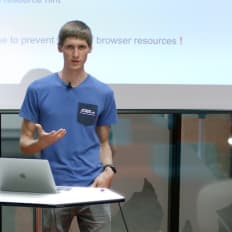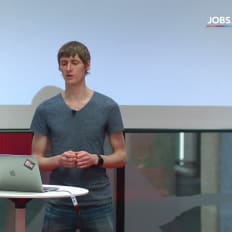
jobs.at Recruiting GmbH
Jürgen Ratzenböck, Head of Technology von jobs.at
Description
Der Head of Technology von jobs.at Jürgen Ratzenböck erzählt im Interview über die flexible Teamorgansiation, wie ein Jobportal selbst an Bewerbungen kommt und welche Technologien zum Einsatz kommen.
By playing the video, you agree to data transfer to YouTube and acknowledge the privacy policy.
Video Summary
In “Jürgen Ratzenböck, Head of Technology von jobs.at,” Jürgen Ratzenböck outlines a small but growing full‑stack team without silos, where engineers switch between database/APIs and client‑side work, collaborate agilely, communicate at eye level, and have broad freedom over implementation, tools, and technologies. He details a standardized hiring flow: an initial interview with him and HR for cultural fit and baseline skills, then a coding challenge reviewed with the dev team, followed by HR and often the CEO; candidates need solid fundamentals rather than a perfect job‑spec match. For tech talent, the stack includes PHP/Laravel, a Vue.js SPA for the employer product, MySQL, Redis, RabbitMQ, GitLab CI and Jenkins for deployments, with strong emphasis on code quality and an evolving CPC model—offering variety and meaningful ownership in day‑to‑day work.
Full‑stack, Ownership, Team First: Inside Engineering at jobs.at with Head of Technology Jürgen Ratzenböck
Why this session matters to engineers
From our DevJobs.at editorial seat, we tuned into “Jürgen Ratzenböck, Head of Technology von jobs.at.” Speaker: Jürgen Ratzenböck. Company: jobs.at Recruiting GmbH. What we heard was a refreshingly clear picture of a compact, fast-growing engineering team that values autonomy, teamwork, and a pragmatic stack. If you’re looking for a place where you can ship, learn, and influence product direction without bureaucratic drag, this is worth your attention.
jobs.at is a job portal. That reality shapes the engineering mission: serve B2B customers who demand performance (including a cost-per-click model) while delivering a sharp, reliable experience for job seekers. The technical bar sits right between these two needs and calls for product sense, sound architecture, and dependable delivery.
Team size, setup, and growth: “Everyone does everything,” on purpose
The development team currently consists of four people, including Jürgen as lead. Two more developers are joining shortly, so the team is growing. For now there are no “classic” backend or frontend departments. Instead, the group operates as a true full‑stack team. As Jürgen puts it:
Everyone does everything.
That breadth makes the day-to-day genuinely varied. One day might be database-heavy or API-driven; the next day it’s client-side rendering in the frontend. This mix isn’t just a learning accelerator—it’s a deliberate cultural choice. Developers are given “a lot of freedom” in how they implement solutions and what tools and technologies they use.
There is a plan for the future. As the team grows, it makes sense to align along product surfaces: one team focusing on the employer side (B2B customers) and another on job seekers. Having a Product Owner for each area is already envisioned. Until then, the full‑stack model maximizes flexibility and momentum.
How they work: Proactive, team-oriented, eye-level collaboration in an agile context
Two things stood out to us: attitude and teamwork. There are no lone wolves. The team works collaboratively, communication happens at eye level, and efficiency is a shared responsibility. The approach is grounded in an agile mindset—pragmatic and effective.
We communicate at eye level and make sure we work as efficiently as possible.
Proactivity is the second hallmark. As a small company, jobs.at isn’t looking for task-takers who wait for instructions. The team wants people who bring ideas, help shape decisions, and take ownership. Freedom in tools and implementation is intentional—paired with accountability for quality and product impact.
Hiring: A standardized process, genuine team fit, and a clear view on skills
The recruiting process is standardized and taps several channels. Being a job portal, jobs.at naturally publishes on its own platform first. In addition, they use Career.at, Devjobs, and Active Sourcing. The latter is essential, as many developers today “prefer to be found rather than apply themselves.”
The selection path follows a straightforward two-step format:
- First interview with the Tech Lead and HR: This is about getting to know each other and assessing whether the person fits the team. Jürgen also asks a few technical questions to gauge skills. The goal: a solid read on cultural fit and a reasonable technical match.
- Second interview with a coding challenge: A small assignment is sent about two days in advance. Candidates then meet the dev team, walk through the solution together, and conclude with Q&A alongside HR—often with the managing director in the room because “she is interested in who we invite and who might work with us.”
Expectations are clear and fair. Cultural fit matters a lot in a small team. Team spirit counts. Technically, there needs to be a solid foundation—not necessarily a 100% match to the job description, but enough to build on. The coding challenge makes that visible.
Cultural fit is very important. Team spirit is very important for us.
Tech stack: PHP/Laravel, Vue.js, MySQL, Redis, RabbitMQ—with GitLab CI and Jenkins for delivery
The core technology is PHP, and the web apps are built on Laravel. The reasons are pragmatic: maturity, a strong community, continuous development, and relief from boilerplate work. In Jürgen’s words:
Our core technology is PHP. We use the Laravel framework for all our web apps … It has a great community … and saves us a lot of work.
On the frontend, one flagship B2B product is the Business Account for employers. Customers can manage their jobs there—create new postings, edit existing ones, and view statistics. The interface is a Single‑Page Application built with Vue.js and communicates with a Laravel API.
For data, jobs.at relies primarily on MySQL. For performance-sensitive use cases—caching and session data for user authentication—they use Redis, which shines exactly there: fast, compact, and reliable.
When apps need to talk to each other—for example, when entering a job should trigger asynchronous actions elsewhere—RabbitMQ is in play. As a message broker with a publish‑subscribe mechanism, it enables loosely coupled communication and clean background processing.
Development and delivery are structured as well: The code lives on GitLab, with CI pipelines running automated tests. Deployments are handled by Jenkins as a build server—push‑button releases to test and live environments. That brings transparency, speed, and reproducibility to shipping.
Stack at a glance
- Backend: PHP with Laravel (web apps, API)
- Frontend: Vue.js Single‑Page Application for the employer Business Account
- Database: MySQL as the primary data store
- Caching/Sessions: Redis for performance and authentication
- Messaging: RabbitMQ (publish‑subscribe) for asynchronous, event‑driven flows
- Version control/CI: GitLab with CI pipelines and automated tests
- Deployment: Jenkins as build server, rollouts to test and live
Product complexity and code quality: Change-friendly by design
As functionality grows, so does complexity—technically and organizationally. Jürgen calls this out directly: a sustained focus on code quality is essential so the product remains safe to change. No one should hesitate to modify code out of fear of side effects appearing “somewhere else.”
We never want the situation where you don’t dare to make changes because of side effects far away from the change.
This isn’t just a quality mantra—it’s a product strategy. A job portal needs to adapt quickly, adjust algorithms, and improve interfaces without getting stuck in its own weight. That only works on a robust code base.
B2B performance: CPC as a continuous, data-driven optimization problem
For B2B customers, jobs.at runs a cost‑per��‑click model. Making it work requires ongoing analysis and optimization: delivering the best possible performance in clicks and applications. That puts demands on the algorithm, which keeps getting more complex as the product scales and features grow.
The cost‑per‑click model … needs a lot of brain power … we analyze how it works and optimize to get the best possible performance in terms of clicks and applications.
For engineers, this means you’re not “just building features.” You’re shaping logic, measuring impact, and improving product performance. If end‑to‑end ownership motivates you, there’s plenty of room to practice it here.
Collaboration, ownership, and growth: Reasons to join
Several concrete reasons stand out for tech talent considering jobs.at Recruiting GmbH:
- Real full‑stack breadth: Database, APIs, frontend—day to day. It’s a strong learning curve and a chance to broaden your toolbox.
- Freedom with accountability: “We’re not looking for developers you have to tell exactly what to do.” The team owns how they build—and holds itself to high standards.
- Team over ego: No lone‑wolf patterns. Eye‑level communication and a shared focus on efficiency keep the pace sustainable.
- Pragmatic, modern stack: Laravel, Vue.js, MySQL, Redis, RabbitMQ—chosen for fit, not hype. GitLab CI and Jenkins keep delivery predictable.
- Product proximity: Job‑portal logic, CPC performance, visible user impact—perfect for engineers who want to see outcomes, not just closed tickets.
- Growth moment: The team is expanding now. New joiners can help shape structures and, over time, take responsibility across the employer vs. job‑seeker product lines.
The hiring flow—clear and candidate‑centric
From a candidate’s perspective, the process is transparent and focused on what matters:
- Sources: jobs.at’s own platform, Career.at, Devjobs, plus Active Sourcing
- Round 1: First interview with the Tech Lead (Jürgen Ratzenböck) and HR—culture and team fit, initial technical screening
- In between: A small coding challenge, sent about two days before round two
- Round 2: Meet the dev team, walk through the solution, close with HR; the managing director often joins
- Goal: A decision that balances culture and skills—no 100% checklist required, but a solid foundation to build on
This ensures candidates meet future teammates early and can demonstrate their approach to problem‑solving. HR keeps the overall fit in sight, and leadership is close to the final impression.
Engineering principles we heard—applied, not buzzwords
Jürgen’s remarks reveal practical principles that matter in growth‑minded product teams:
- Change‑friendly code: Quality reduces fear of change. That’s how products stay agile as they scale.
- Asynchronous architecture: RabbitMQ decouples events and services, enabling resilient background processing.
- Automation where it counts: GitLab CI for tests, Jenkins for releases—pipelines remove friction and increase reliability.
- Product mindset in engineering: CPC optimization is a team sport. Engineering delivers code and measurable product performance.
What’s next: Thinking ahead without over‑engineering today
Looking forward, a split into two product areas—employer side and job‑seeker side—makes sense as the team and roadmap grow. A Product Owner for each stream would clarify accountability. For now, jobs.at is doubling down on the advantages of a compact full‑stack team.
The approach, as described by Jürgen Ratzenböck, is sober and effective: clear delivery processes, well‑chosen technologies, team discipline, and respect for product complexity. It doesn’t feel overloaded or dogmatic—more like good engineering work.
Closing thought: A place for builders who care about quality
If you want to take responsibility in a small, impact‑oriented full‑stack team, jobs.at Recruiting GmbH is a strong proposition. The mix of autonomy, teamwork, a solid toolset, and a product with daily market contact is rare—and it calls for people who value exactly that.
The session “Jürgen Ratzenböck, Head of Technology von jobs.at” made it clear what matters here: product‑proximate engineering, a shared understanding of quality, straightforward processes, and a growing team eager to shape what’s next. In Jürgen’s words, the invitation is implicit:
You really have a lot of freedom … and that makes it exciting and challenging.
If that resonates, this is a chance to practice full‑stack in the best sense—and help shape a job portal that delivers performance for employers while giving job seekers a clear, fast experience.
More Tech Talks
jobs.at Recruiting GmbH How we optimize our Front End
Jürgen Ratzenböck von jobs.at zeigt in seinem devjobs.at TechTalk an welchen Schrauben das Linzer Unternehmen dreht, um die Performance ihrer Webseite zu optimieren.
Watch nowjobs.at Recruiting GmbH SPA without API
Jürgen Ratzenböck von jobs.at spricht in seinem devjobs.at TechTalk "SPA without API" darüber, welche Vorteile und Challenges dieser Ansatz mit sich bringt und gibt technische Einblicke in das Thema.
Watch now


